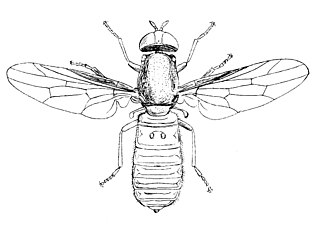Related Research Articles

True flies are insects of the order Diptera, the name being derived from the Greek δι- di- "two", and πτερόν pteron "wings". Insects of this order use only a single pair of wings to fly, the hindwings having evolved into advanced mechanosensory organs known as halteres, which act as high-speed sensors of rotational movement and allow dipterans to perform advanced aerobatics. Diptera is a large order containing an estimated 1,000,000 species including horse-flies, crane flies, hoverflies and others, although only about 125,000 species have been described.
Harold Oldroyd was a British entomologist, born in 1914. He specialised in the biology of flies, and wrote many books, especially popular science that helped entomology to reach a broader public. His The Natural History of Flies is considered to be the "fly Bible". Although his speciality was the Diptera, he acknowledged that they are not a popular topic: "Breeding in dung, carrion, sewage and even living flesh, flies are a subject of disgust...not to be discussed in polite society". It was Oldroyd who proposed the idea of hyphenating the names of true flies (Diptera) to distinguish them from other insects with "fly" in their names. Thus, the "house-fly", "crane-fly" and "blow-fly" would be true flies, while the "dragonfly", "scorpion fly" and so on belong to other orders. He also debunked the calculation that a single pair of house-flies, if allowed to reproduce without inhibitions could, within nine months, number 5.6×1012 individuals, enough to cover the Earth to a thickness of 14.3 m (47 ft). Oldroyd calculated that such a layer would only cover Germany, but remarked "that is still a lot of flies".

The Nematocera are a suborder of elongated flies with thin, segmented antennae and mostly aquatic larvae. Major families in the suborder include the mosquitoes, crane flies, gnats, black flies, and a group of families described as midges.

The Micropezidae are a moderate-sized family of acalyptrate muscoid flies in the insect order Diptera, comprising about 500 species in about 50 genera and five subfamilies worldwide,. They are most diverse in tropical and subtropical habitats, especially in the Neotropical Region.
Evelyn Cecil Muschamp d’Assis Fonseca was a British dipterist. He was responsible for formally naming a number of fly species, including:

The Scenopinidae or window flies are a small family of flies (Diptera), distributed worldwide. In buildings, they are often taken at windows, hence the common name window flies.
Dilbert Elmo Hardy was an American entomologist who specialized in Diptera systematics.
Elwood Curtin Zimmerman was an American entomologist best known for his two multivolume series: Insects of Hawaii published by the University of Hawaiʻi Press and Australian Weevils published by Australia's CSIRO.

Arachnomyia is a genus of flies in the family Dolichopodidae. It is known from Australia.

Diaphorus is a genus of flies in the family Dolichopodidae. Lyroneurus is considered by some authors to be a subgenus of this genus.
Eurynogaster is a genus of flies in the family Dolichopodidae, endemic to Hawaii. It is part of the Eurynogaster complex of genera.
Paraclius is a genus of fly in the family Dolichopodidae.
Lispocephala is a very large genus of true flies of the family Muscidae.
The Ironomyiidae, or ironic flies, are a small family of insects of the order Diptera. Historically, they have been included in the family Platypezidae, and includes three extant species and a number of extinct fossil species.
The Diptera is a very large and diverse order of mostly small to medium-sized insects. They have prominent compound eyes on a mobile head, and one pair of functional, membraneous wings, which are attached to a complex mesothorax. The second pair of wings, on the metathorax, are reduced to halteres. The order's fundamental peculiarity is its remarkable specialization in terms of wing shape and the morpho-anatomical adaptation of the thorax – features which lend particular agility to its flying forms. The filiform, stylate or aristate antennae correlate with the Nematocera, Brachycera and Cyclorrhapha taxa respectively. It displays substantial morphological uniformity in lower taxa, especially at the level of genus or species. The configuration of integumental bristles is of fundamental importance in their taxonomy, as is wing venation. It displays a complete metamorphosis, or holometabolous development. The larvae are legless, and have head capsules with mandibulate mouthparts in the Nematocera. The larvae of "higher flies" (Brachycera) are however headless and wormlike, and display only three instars. Pupae are obtect in the Nematocera, or coarcate in Brachycera.
Diptera is an order of winged insects commonly known as flies. Diptera, which are one of the most successful groups of organisms on Earth, are very diverse biologically. None are truly marine but they occupy virtually every terrestrial niche. Many have co-evolved in association with plants and animals. The Diptera are a very significant group in the decomposition and degeneration of plant and animal matter, are instrumental in the breakdown and release of nutrients back into the soil, and whose larvae supplement the diet of higher agrarian organisms. They are also an important component in food chains.

Sciapodinae is a subfamily of flies in the family Dolichopodidae.
Elmoia is a genus of flies in the family Dolichopodidae, endemic to Hawaii. It is part of the Eurynogaster complex of genera. The genus is named in honor of D. Elmo Hardy.
References
- ↑ "University of Hawaii Press: Insects of Hawaii" . Retrieved 2009-02-24.